Comprehensive Nursing Report: PCOS Case Study and Patient Management
VerifiedAdded on 2022/11/19
|11
|3293
|473
Report
AI Summary
This report presents a comprehensive analysis of a nursing case study focusing on a 26-year-old female patient, Sharon Munroe, diagnosed with Polycystic Ovarian Syndrome (PCOS). The report delves into the relevant assessments required for the patient, considering factors like irregular menses, weight gain, hirsutism, acne, and infertility. It discusses the crucial roles of the sexual health team members, including gynecologists, general physicians, nurses, dieticians, psychiatrists, and other specialists, in providing holistic care. Furthermore, the report outlines the patient's education needs, emphasizing the importance of understanding PCOS aetiology, lifestyle modifications, medication management, and available support services. The report highlights the significance of patient education in managing symptoms, preventing complications, and improving the overall quality of life for individuals with PCOS. This report follows APA formatting and includes an extensive list of references.
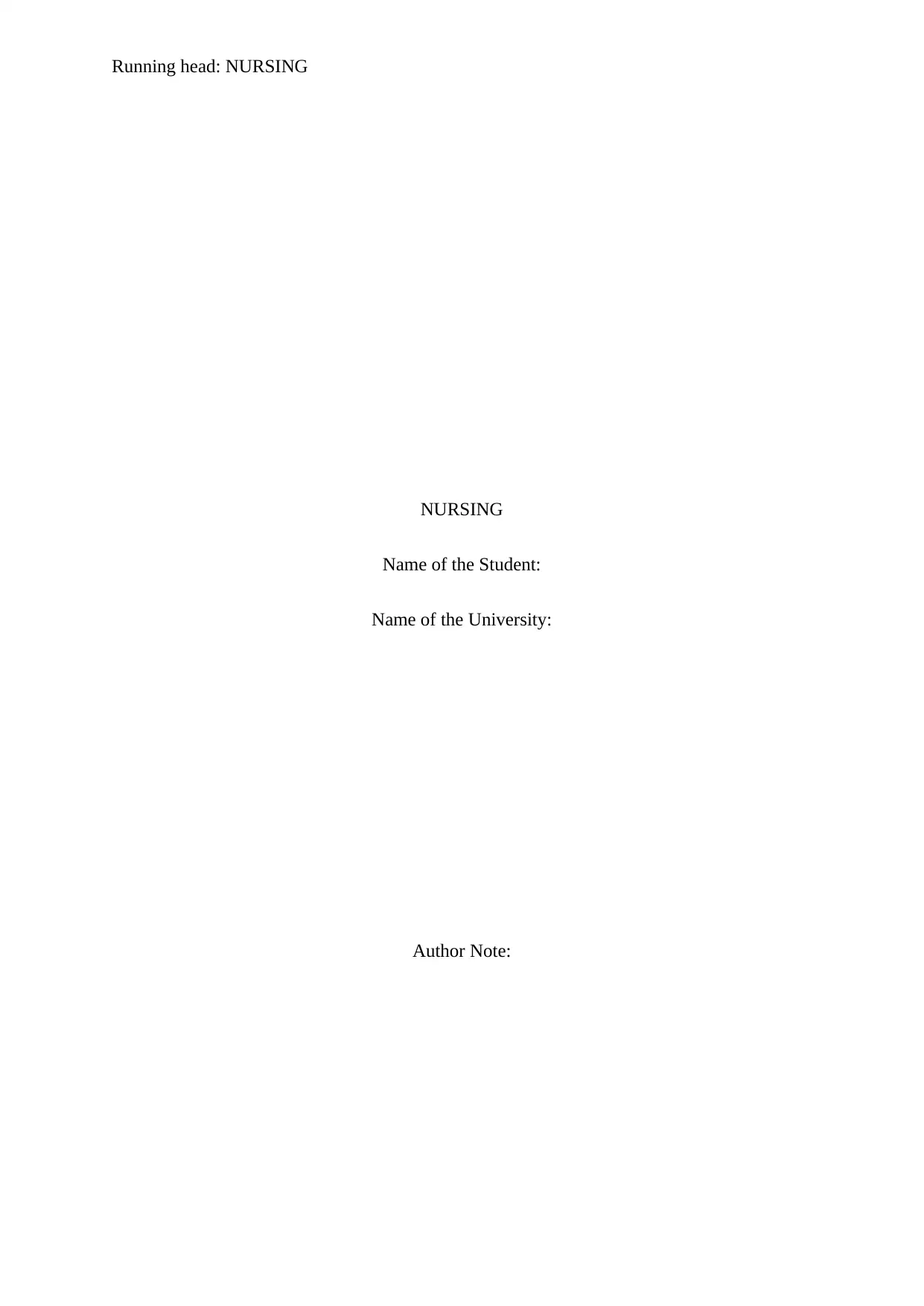
Running head: NURSING
NURSING
Name of the Student:
Name of the University:
Author Note:
NURSING
Name of the Student:
Name of the University:
Author Note:
Paraphrase This Document
Need a fresh take? Get an instant paraphrase of this document with our AI Paraphraser
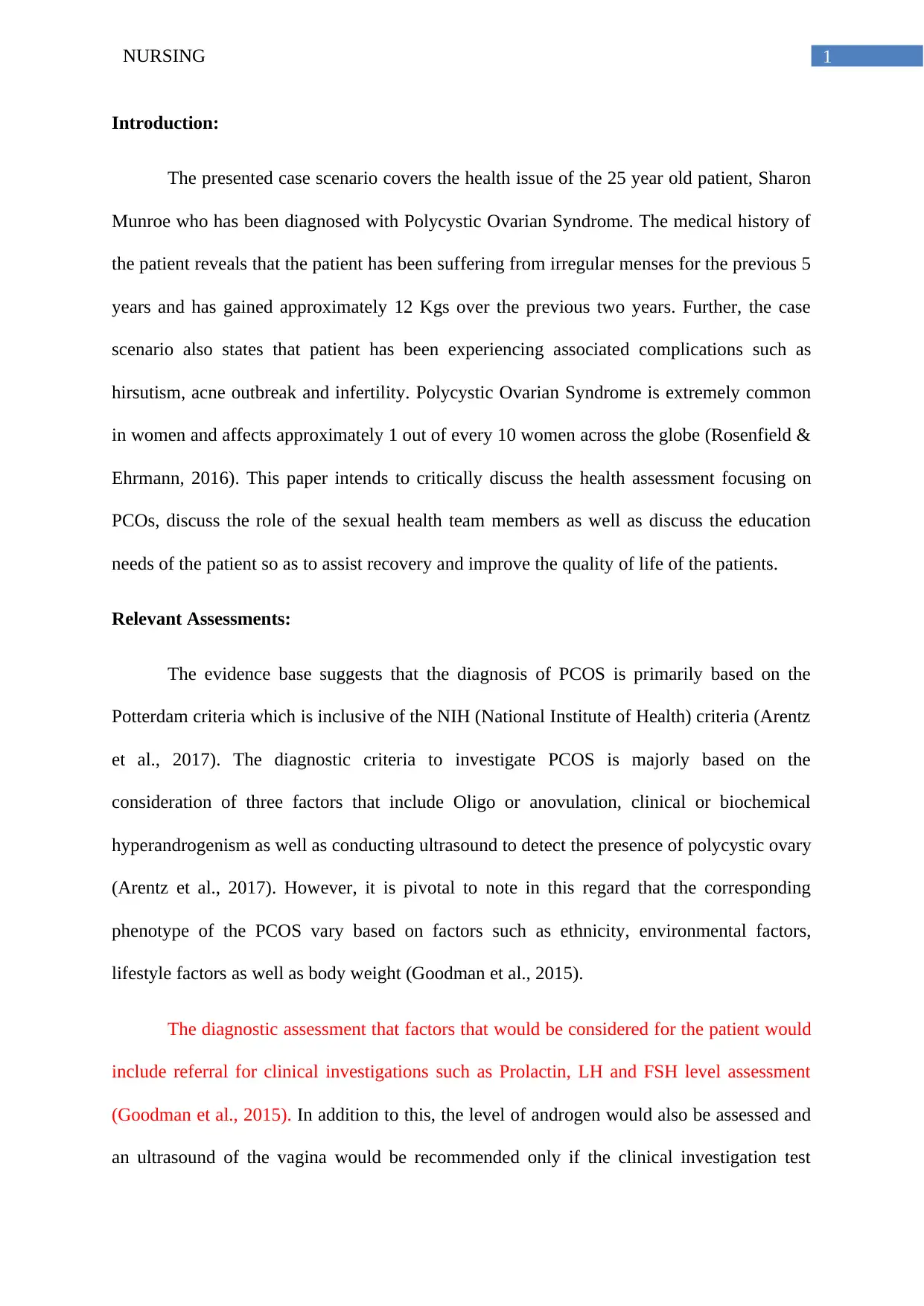
1NURSING
Introduction:
The presented case scenario covers the health issue of the 25 year old patient, Sharon
Munroe who has been diagnosed with Polycystic Ovarian Syndrome. The medical history of
the patient reveals that the patient has been suffering from irregular menses for the previous 5
years and has gained approximately 12 Kgs over the previous two years. Further, the case
scenario also states that patient has been experiencing associated complications such as
hirsutism, acne outbreak and infertility. Polycystic Ovarian Syndrome is extremely common
in women and affects approximately 1 out of every 10 women across the globe (Rosenfield &
Ehrmann, 2016). This paper intends to critically discuss the health assessment focusing on
PCOs, discuss the role of the sexual health team members as well as discuss the education
needs of the patient so as to assist recovery and improve the quality of life of the patients.
Relevant Assessments:
The evidence base suggests that the diagnosis of PCOS is primarily based on the
Potterdam criteria which is inclusive of the NIH (National Institute of Health) criteria (Arentz
et al., 2017). The diagnostic criteria to investigate PCOS is majorly based on the
consideration of three factors that include Oligo or anovulation, clinical or biochemical
hyperandrogenism as well as conducting ultrasound to detect the presence of polycystic ovary
(Arentz et al., 2017). However, it is pivotal to note in this regard that the corresponding
phenotype of the PCOS vary based on factors such as ethnicity, environmental factors,
lifestyle factors as well as body weight (Goodman et al., 2015).
The diagnostic assessment that factors that would be considered for the patient would
include referral for clinical investigations such as Prolactin, LH and FSH level assessment
(Goodman et al., 2015). In addition to this, the level of androgen would also be assessed and
an ultrasound of the vagina would be recommended only if the clinical investigation test
Introduction:
The presented case scenario covers the health issue of the 25 year old patient, Sharon
Munroe who has been diagnosed with Polycystic Ovarian Syndrome. The medical history of
the patient reveals that the patient has been suffering from irregular menses for the previous 5
years and has gained approximately 12 Kgs over the previous two years. Further, the case
scenario also states that patient has been experiencing associated complications such as
hirsutism, acne outbreak and infertility. Polycystic Ovarian Syndrome is extremely common
in women and affects approximately 1 out of every 10 women across the globe (Rosenfield &
Ehrmann, 2016). This paper intends to critically discuss the health assessment focusing on
PCOs, discuss the role of the sexual health team members as well as discuss the education
needs of the patient so as to assist recovery and improve the quality of life of the patients.
Relevant Assessments:
The evidence base suggests that the diagnosis of PCOS is primarily based on the
Potterdam criteria which is inclusive of the NIH (National Institute of Health) criteria (Arentz
et al., 2017). The diagnostic criteria to investigate PCOS is majorly based on the
consideration of three factors that include Oligo or anovulation, clinical or biochemical
hyperandrogenism as well as conducting ultrasound to detect the presence of polycystic ovary
(Arentz et al., 2017). However, it is pivotal to note in this regard that the corresponding
phenotype of the PCOS vary based on factors such as ethnicity, environmental factors,
lifestyle factors as well as body weight (Goodman et al., 2015).
The diagnostic assessment that factors that would be considered for the patient would
include referral for clinical investigations such as Prolactin, LH and FSH level assessment
(Goodman et al., 2015). In addition to this, the level of androgen would also be assessed and
an ultrasound of the vagina would be recommended only if the clinical investigation test
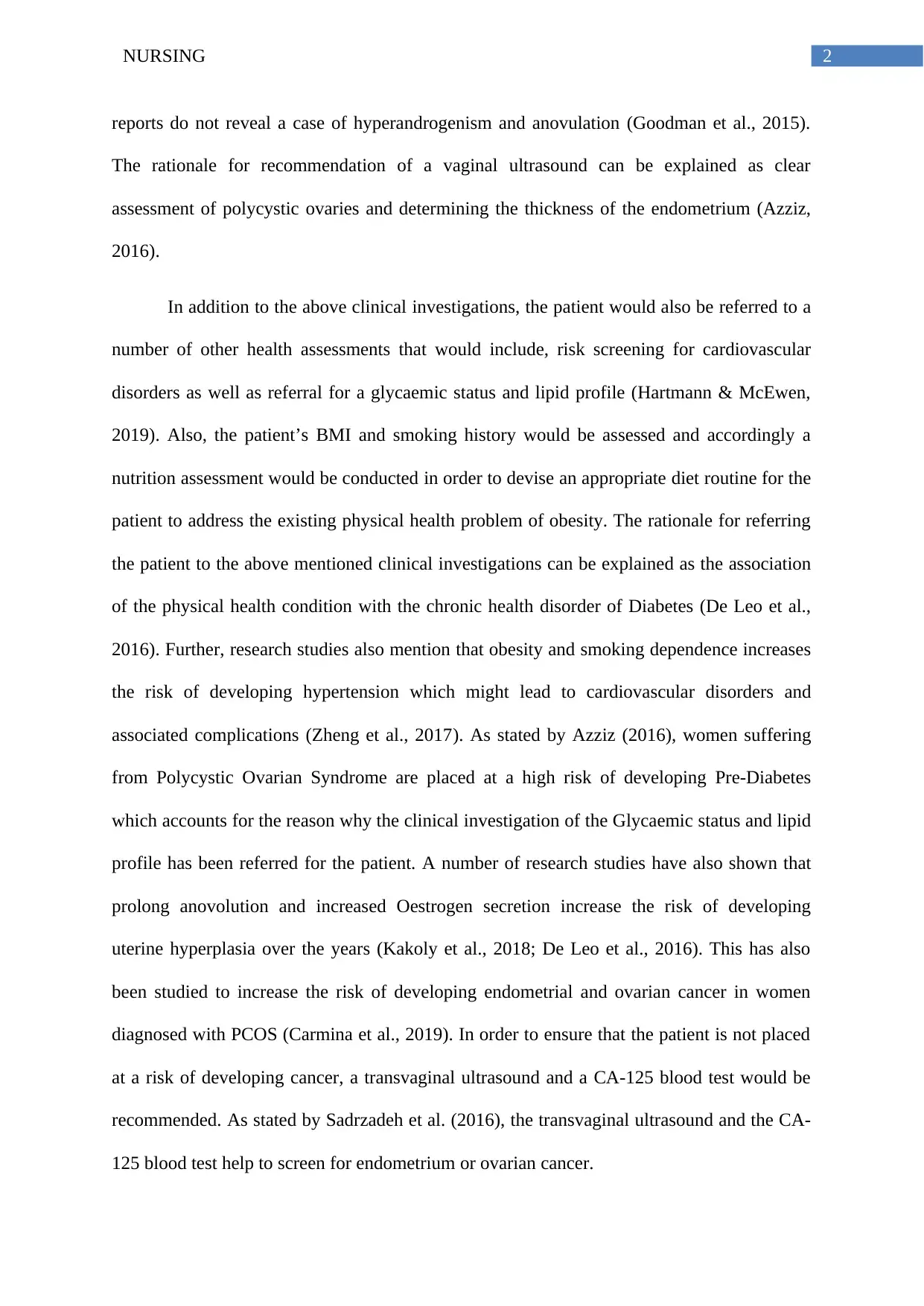
2NURSING
reports do not reveal a case of hyperandrogenism and anovulation (Goodman et al., 2015).
The rationale for recommendation of a vaginal ultrasound can be explained as clear
assessment of polycystic ovaries and determining the thickness of the endometrium (Azziz,
2016).
In addition to the above clinical investigations, the patient would also be referred to a
number of other health assessments that would include, risk screening for cardiovascular
disorders as well as referral for a glycaemic status and lipid profile (Hartmann & McEwen,
2019). Also, the patient’s BMI and smoking history would be assessed and accordingly a
nutrition assessment would be conducted in order to devise an appropriate diet routine for the
patient to address the existing physical health problem of obesity. The rationale for referring
the patient to the above mentioned clinical investigations can be explained as the association
of the physical health condition with the chronic health disorder of Diabetes (De Leo et al.,
2016). Further, research studies also mention that obesity and smoking dependence increases
the risk of developing hypertension which might lead to cardiovascular disorders and
associated complications (Zheng et al., 2017). As stated by Azziz (2016), women suffering
from Polycystic Ovarian Syndrome are placed at a high risk of developing Pre-Diabetes
which accounts for the reason why the clinical investigation of the Glycaemic status and lipid
profile has been referred for the patient. A number of research studies have also shown that
prolong anovolution and increased Oestrogen secretion increase the risk of developing
uterine hyperplasia over the years (Kakoly et al., 2018; De Leo et al., 2016). This has also
been studied to increase the risk of developing endometrial and ovarian cancer in women
diagnosed with PCOS (Carmina et al., 2019). In order to ensure that the patient is not placed
at a risk of developing cancer, a transvaginal ultrasound and a CA-125 blood test would be
recommended. As stated by Sadrzadeh et al. (2016), the transvaginal ultrasound and the CA-
125 blood test help to screen for endometrium or ovarian cancer.
reports do not reveal a case of hyperandrogenism and anovulation (Goodman et al., 2015).
The rationale for recommendation of a vaginal ultrasound can be explained as clear
assessment of polycystic ovaries and determining the thickness of the endometrium (Azziz,
2016).
In addition to the above clinical investigations, the patient would also be referred to a
number of other health assessments that would include, risk screening for cardiovascular
disorders as well as referral for a glycaemic status and lipid profile (Hartmann & McEwen,
2019). Also, the patient’s BMI and smoking history would be assessed and accordingly a
nutrition assessment would be conducted in order to devise an appropriate diet routine for the
patient to address the existing physical health problem of obesity. The rationale for referring
the patient to the above mentioned clinical investigations can be explained as the association
of the physical health condition with the chronic health disorder of Diabetes (De Leo et al.,
2016). Further, research studies also mention that obesity and smoking dependence increases
the risk of developing hypertension which might lead to cardiovascular disorders and
associated complications (Zheng et al., 2017). As stated by Azziz (2016), women suffering
from Polycystic Ovarian Syndrome are placed at a high risk of developing Pre-Diabetes
which accounts for the reason why the clinical investigation of the Glycaemic status and lipid
profile has been referred for the patient. A number of research studies have also shown that
prolong anovolution and increased Oestrogen secretion increase the risk of developing
uterine hyperplasia over the years (Kakoly et al., 2018; De Leo et al., 2016). This has also
been studied to increase the risk of developing endometrial and ovarian cancer in women
diagnosed with PCOS (Carmina et al., 2019). In order to ensure that the patient is not placed
at a risk of developing cancer, a transvaginal ultrasound and a CA-125 blood test would be
recommended. As stated by Sadrzadeh et al. (2016), the transvaginal ultrasound and the CA-
125 blood test help to screen for endometrium or ovarian cancer.
⊘ This is a preview!⊘
Do you want full access?
Subscribe today to unlock all pages.

Trusted by 1+ million students worldwide
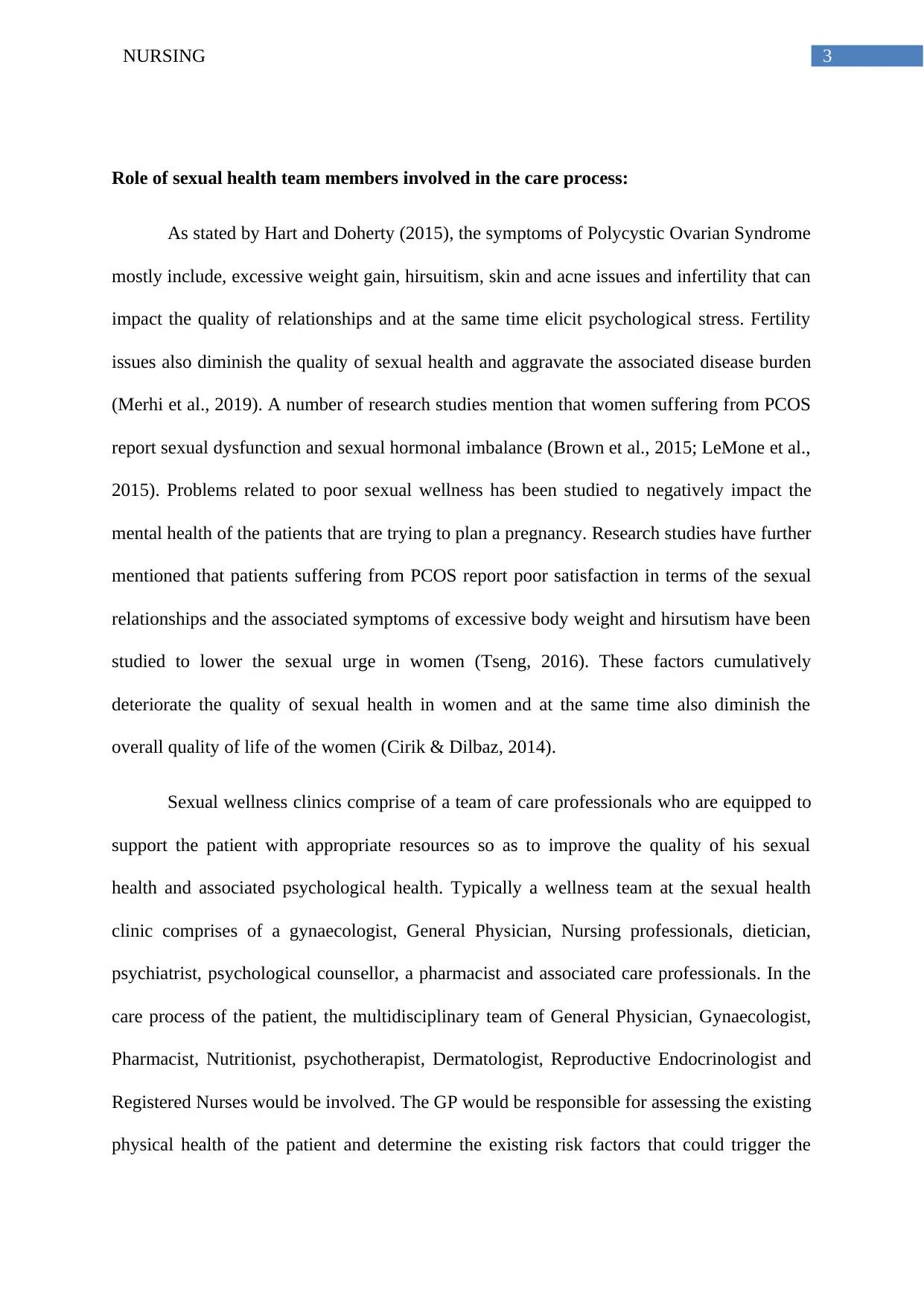
3NURSING
Role of sexual health team members involved in the care process:
As stated by Hart and Doherty (2015), the symptoms of Polycystic Ovarian Syndrome
mostly include, excessive weight gain, hirsuitism, skin and acne issues and infertility that can
impact the quality of relationships and at the same time elicit psychological stress. Fertility
issues also diminish the quality of sexual health and aggravate the associated disease burden
(Merhi et al., 2019). A number of research studies mention that women suffering from PCOS
report sexual dysfunction and sexual hormonal imbalance (Brown et al., 2015; LeMone et al.,
2015). Problems related to poor sexual wellness has been studied to negatively impact the
mental health of the patients that are trying to plan a pregnancy. Research studies have further
mentioned that patients suffering from PCOS report poor satisfaction in terms of the sexual
relationships and the associated symptoms of excessive body weight and hirsutism have been
studied to lower the sexual urge in women (Tseng, 2016). These factors cumulatively
deteriorate the quality of sexual health in women and at the same time also diminish the
overall quality of life of the women (Cirik & Dilbaz, 2014).
Sexual wellness clinics comprise of a team of care professionals who are equipped to
support the patient with appropriate resources so as to improve the quality of his sexual
health and associated psychological health. Typically a wellness team at the sexual health
clinic comprises of a gynaecologist, General Physician, Nursing professionals, dietician,
psychiatrist, psychological counsellor, a pharmacist and associated care professionals. In the
care process of the patient, the multidisciplinary team of General Physician, Gynaecologist,
Pharmacist, Nutritionist, psychotherapist, Dermatologist, Reproductive Endocrinologist and
Registered Nurses would be involved. The GP would be responsible for assessing the existing
physical health of the patient and determine the existing risk factors that could trigger the
Role of sexual health team members involved in the care process:
As stated by Hart and Doherty (2015), the symptoms of Polycystic Ovarian Syndrome
mostly include, excessive weight gain, hirsuitism, skin and acne issues and infertility that can
impact the quality of relationships and at the same time elicit psychological stress. Fertility
issues also diminish the quality of sexual health and aggravate the associated disease burden
(Merhi et al., 2019). A number of research studies mention that women suffering from PCOS
report sexual dysfunction and sexual hormonal imbalance (Brown et al., 2015; LeMone et al.,
2015). Problems related to poor sexual wellness has been studied to negatively impact the
mental health of the patients that are trying to plan a pregnancy. Research studies have further
mentioned that patients suffering from PCOS report poor satisfaction in terms of the sexual
relationships and the associated symptoms of excessive body weight and hirsutism have been
studied to lower the sexual urge in women (Tseng, 2016). These factors cumulatively
deteriorate the quality of sexual health in women and at the same time also diminish the
overall quality of life of the women (Cirik & Dilbaz, 2014).
Sexual wellness clinics comprise of a team of care professionals who are equipped to
support the patient with appropriate resources so as to improve the quality of his sexual
health and associated psychological health. Typically a wellness team at the sexual health
clinic comprises of a gynaecologist, General Physician, Nursing professionals, dietician,
psychiatrist, psychological counsellor, a pharmacist and associated care professionals. In the
care process of the patient, the multidisciplinary team of General Physician, Gynaecologist,
Pharmacist, Nutritionist, psychotherapist, Dermatologist, Reproductive Endocrinologist and
Registered Nurses would be involved. The GP would be responsible for assessing the existing
physical health of the patient and determine the existing risk factors that could trigger the
Paraphrase This Document
Need a fresh take? Get an instant paraphrase of this document with our AI Paraphraser
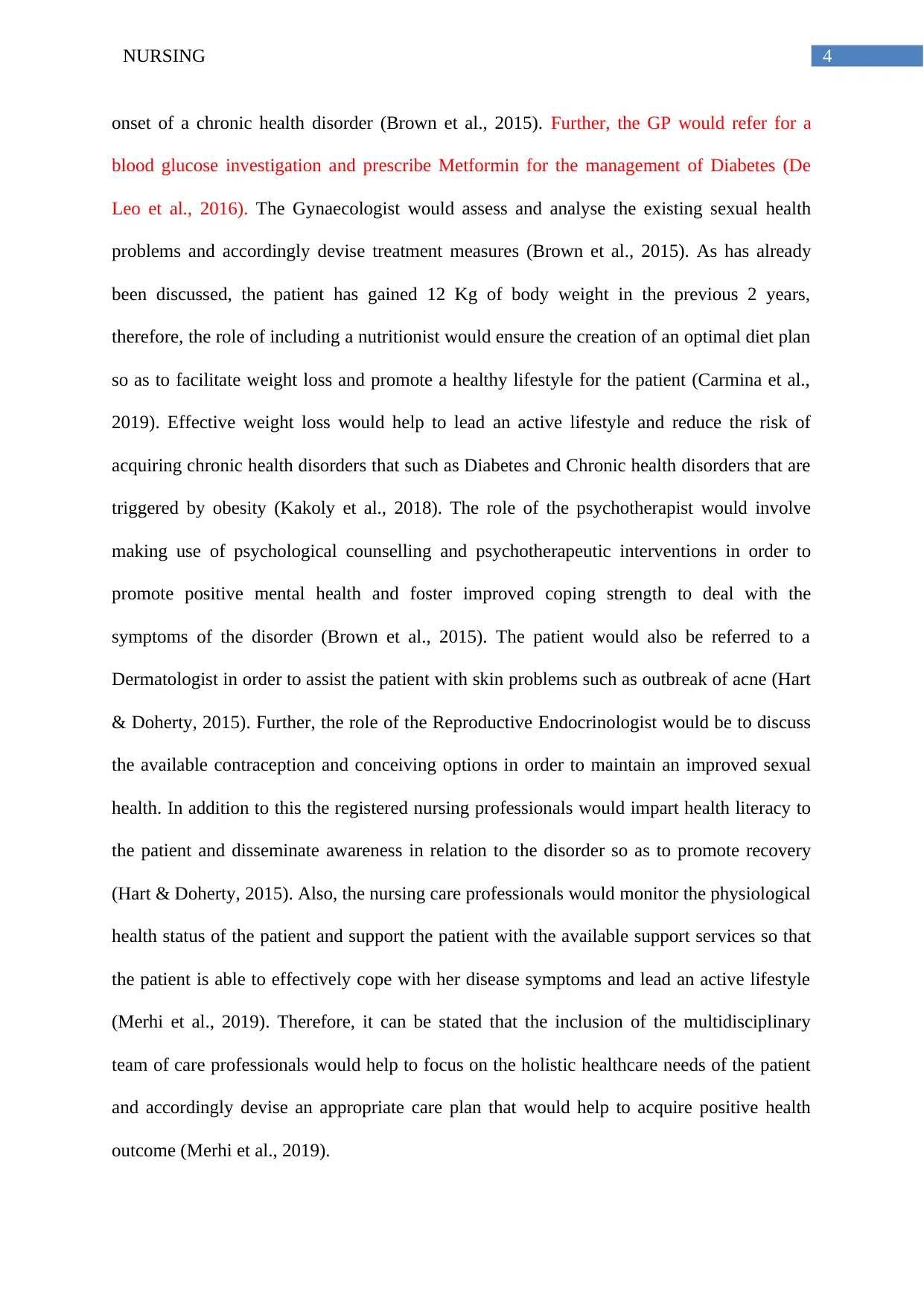
4NURSING
onset of a chronic health disorder (Brown et al., 2015). Further, the GP would refer for a
blood glucose investigation and prescribe Metformin for the management of Diabetes (De
Leo et al., 2016). The Gynaecologist would assess and analyse the existing sexual health
problems and accordingly devise treatment measures (Brown et al., 2015). As has already
been discussed, the patient has gained 12 Kg of body weight in the previous 2 years,
therefore, the role of including a nutritionist would ensure the creation of an optimal diet plan
so as to facilitate weight loss and promote a healthy lifestyle for the patient (Carmina et al.,
2019). Effective weight loss would help to lead an active lifestyle and reduce the risk of
acquiring chronic health disorders that such as Diabetes and Chronic health disorders that are
triggered by obesity (Kakoly et al., 2018). The role of the psychotherapist would involve
making use of psychological counselling and psychotherapeutic interventions in order to
promote positive mental health and foster improved coping strength to deal with the
symptoms of the disorder (Brown et al., 2015). The patient would also be referred to a
Dermatologist in order to assist the patient with skin problems such as outbreak of acne (Hart
& Doherty, 2015). Further, the role of the Reproductive Endocrinologist would be to discuss
the available contraception and conceiving options in order to maintain an improved sexual
health. In addition to this the registered nursing professionals would impart health literacy to
the patient and disseminate awareness in relation to the disorder so as to promote recovery
(Hart & Doherty, 2015). Also, the nursing care professionals would monitor the physiological
health status of the patient and support the patient with the available support services so that
the patient is able to effectively cope with her disease symptoms and lead an active lifestyle
(Merhi et al., 2019). Therefore, it can be stated that the inclusion of the multidisciplinary
team of care professionals would help to focus on the holistic healthcare needs of the patient
and accordingly devise an appropriate care plan that would help to acquire positive health
outcome (Merhi et al., 2019).
onset of a chronic health disorder (Brown et al., 2015). Further, the GP would refer for a
blood glucose investigation and prescribe Metformin for the management of Diabetes (De
Leo et al., 2016). The Gynaecologist would assess and analyse the existing sexual health
problems and accordingly devise treatment measures (Brown et al., 2015). As has already
been discussed, the patient has gained 12 Kg of body weight in the previous 2 years,
therefore, the role of including a nutritionist would ensure the creation of an optimal diet plan
so as to facilitate weight loss and promote a healthy lifestyle for the patient (Carmina et al.,
2019). Effective weight loss would help to lead an active lifestyle and reduce the risk of
acquiring chronic health disorders that such as Diabetes and Chronic health disorders that are
triggered by obesity (Kakoly et al., 2018). The role of the psychotherapist would involve
making use of psychological counselling and psychotherapeutic interventions in order to
promote positive mental health and foster improved coping strength to deal with the
symptoms of the disorder (Brown et al., 2015). The patient would also be referred to a
Dermatologist in order to assist the patient with skin problems such as outbreak of acne (Hart
& Doherty, 2015). Further, the role of the Reproductive Endocrinologist would be to discuss
the available contraception and conceiving options in order to maintain an improved sexual
health. In addition to this the registered nursing professionals would impart health literacy to
the patient and disseminate awareness in relation to the disorder so as to promote recovery
(Hart & Doherty, 2015). Also, the nursing care professionals would monitor the physiological
health status of the patient and support the patient with the available support services so that
the patient is able to effectively cope with her disease symptoms and lead an active lifestyle
(Merhi et al., 2019). Therefore, it can be stated that the inclusion of the multidisciplinary
team of care professionals would help to focus on the holistic healthcare needs of the patient
and accordingly devise an appropriate care plan that would help to acquire positive health
outcome (Merhi et al., 2019).
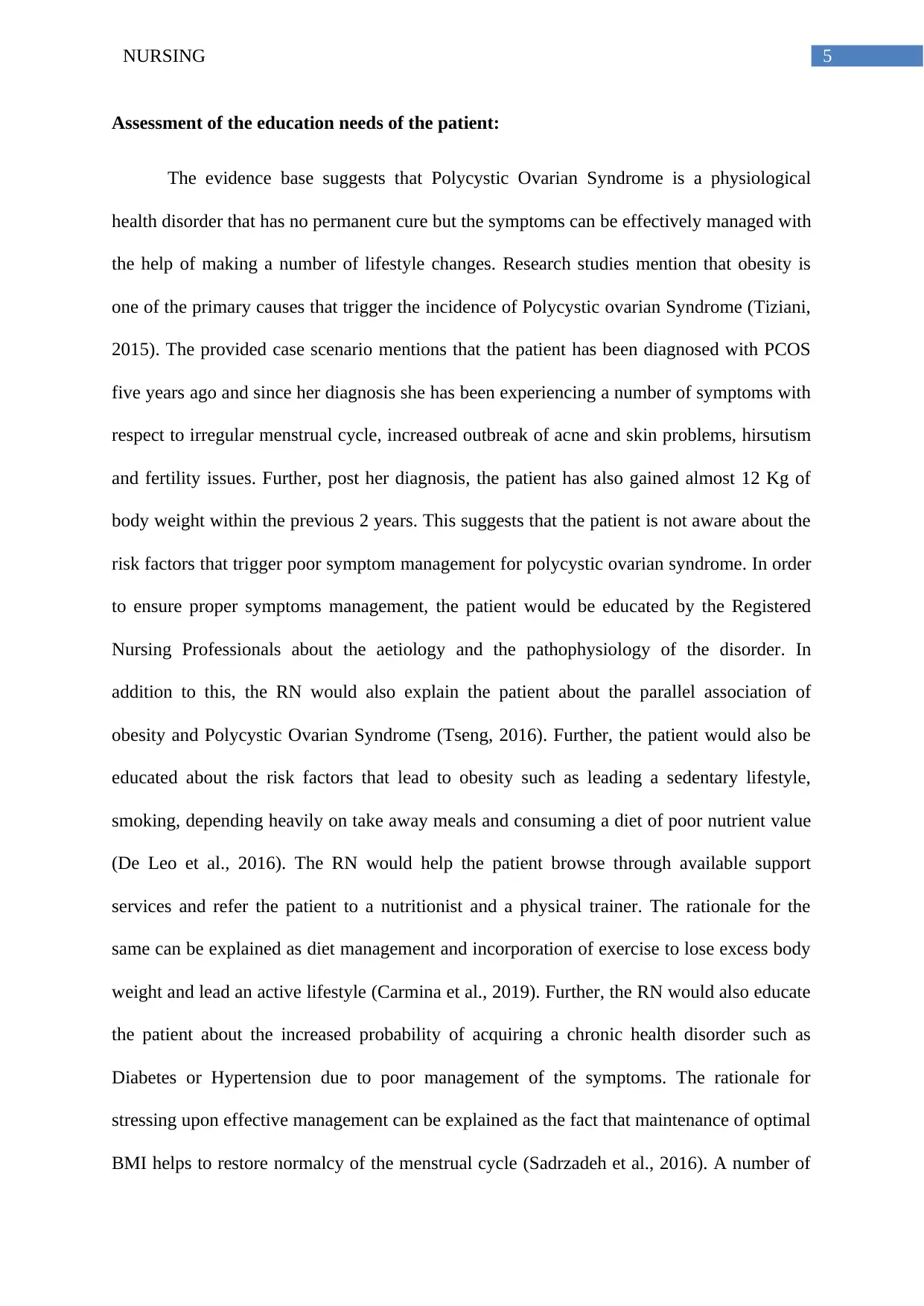
5NURSING
Assessment of the education needs of the patient:
The evidence base suggests that Polycystic Ovarian Syndrome is a physiological
health disorder that has no permanent cure but the symptoms can be effectively managed with
the help of making a number of lifestyle changes. Research studies mention that obesity is
one of the primary causes that trigger the incidence of Polycystic ovarian Syndrome (Tiziani,
2015). The provided case scenario mentions that the patient has been diagnosed with PCOS
five years ago and since her diagnosis she has been experiencing a number of symptoms with
respect to irregular menstrual cycle, increased outbreak of acne and skin problems, hirsutism
and fertility issues. Further, post her diagnosis, the patient has also gained almost 12 Kg of
body weight within the previous 2 years. This suggests that the patient is not aware about the
risk factors that trigger poor symptom management for polycystic ovarian syndrome. In order
to ensure proper symptoms management, the patient would be educated by the Registered
Nursing Professionals about the aetiology and the pathophysiology of the disorder. In
addition to this, the RN would also explain the patient about the parallel association of
obesity and Polycystic Ovarian Syndrome (Tseng, 2016). Further, the patient would also be
educated about the risk factors that lead to obesity such as leading a sedentary lifestyle,
smoking, depending heavily on take away meals and consuming a diet of poor nutrient value
(De Leo et al., 2016). The RN would help the patient browse through available support
services and refer the patient to a nutritionist and a physical trainer. The rationale for the
same can be explained as diet management and incorporation of exercise to lose excess body
weight and lead an active lifestyle (Carmina et al., 2019). Further, the RN would also educate
the patient about the increased probability of acquiring a chronic health disorder such as
Diabetes or Hypertension due to poor management of the symptoms. The rationale for
stressing upon effective management can be explained as the fact that maintenance of optimal
BMI helps to restore normalcy of the menstrual cycle (Sadrzadeh et al., 2016). A number of
Assessment of the education needs of the patient:
The evidence base suggests that Polycystic Ovarian Syndrome is a physiological
health disorder that has no permanent cure but the symptoms can be effectively managed with
the help of making a number of lifestyle changes. Research studies mention that obesity is
one of the primary causes that trigger the incidence of Polycystic ovarian Syndrome (Tiziani,
2015). The provided case scenario mentions that the patient has been diagnosed with PCOS
five years ago and since her diagnosis she has been experiencing a number of symptoms with
respect to irregular menstrual cycle, increased outbreak of acne and skin problems, hirsutism
and fertility issues. Further, post her diagnosis, the patient has also gained almost 12 Kg of
body weight within the previous 2 years. This suggests that the patient is not aware about the
risk factors that trigger poor symptom management for polycystic ovarian syndrome. In order
to ensure proper symptoms management, the patient would be educated by the Registered
Nursing Professionals about the aetiology and the pathophysiology of the disorder. In
addition to this, the RN would also explain the patient about the parallel association of
obesity and Polycystic Ovarian Syndrome (Tseng, 2016). Further, the patient would also be
educated about the risk factors that lead to obesity such as leading a sedentary lifestyle,
smoking, depending heavily on take away meals and consuming a diet of poor nutrient value
(De Leo et al., 2016). The RN would help the patient browse through available support
services and refer the patient to a nutritionist and a physical trainer. The rationale for the
same can be explained as diet management and incorporation of exercise to lose excess body
weight and lead an active lifestyle (Carmina et al., 2019). Further, the RN would also educate
the patient about the increased probability of acquiring a chronic health disorder such as
Diabetes or Hypertension due to poor management of the symptoms. The rationale for
stressing upon effective management can be explained as the fact that maintenance of optimal
BMI helps to restore normalcy of the menstrual cycle (Sadrzadeh et al., 2016). A number of
⊘ This is a preview!⊘
Do you want full access?
Subscribe today to unlock all pages.

Trusted by 1+ million students worldwide
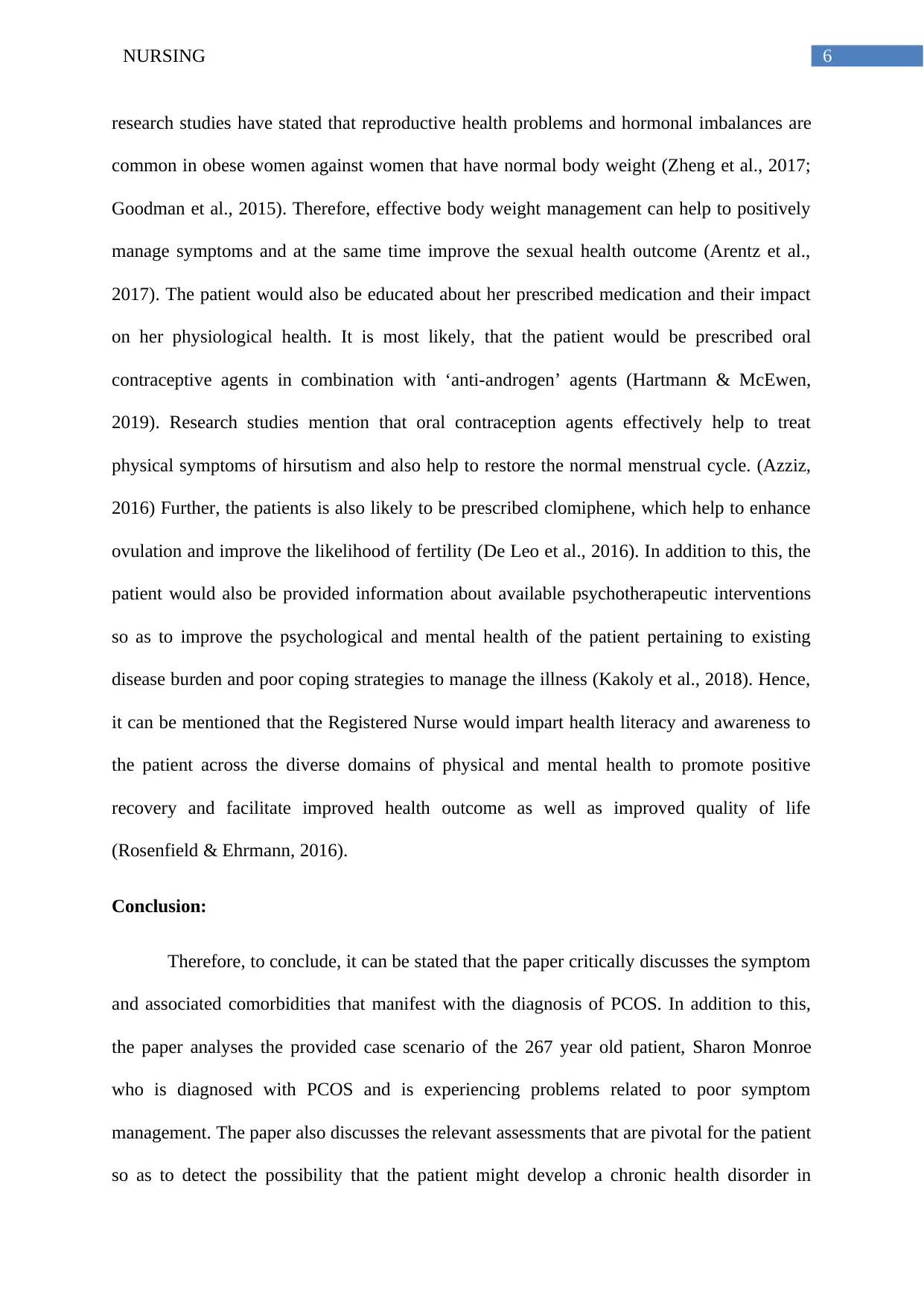
6NURSING
research studies have stated that reproductive health problems and hormonal imbalances are
common in obese women against women that have normal body weight (Zheng et al., 2017;
Goodman et al., 2015). Therefore, effective body weight management can help to positively
manage symptoms and at the same time improve the sexual health outcome (Arentz et al.,
2017). The patient would also be educated about her prescribed medication and their impact
on her physiological health. It is most likely, that the patient would be prescribed oral
contraceptive agents in combination with ‘anti-androgen’ agents (Hartmann & McEwen,
2019). Research studies mention that oral contraception agents effectively help to treat
physical symptoms of hirsutism and also help to restore the normal menstrual cycle. (Azziz,
2016) Further, the patients is also likely to be prescribed clomiphene, which help to enhance
ovulation and improve the likelihood of fertility (De Leo et al., 2016). In addition to this, the
patient would also be provided information about available psychotherapeutic interventions
so as to improve the psychological and mental health of the patient pertaining to existing
disease burden and poor coping strategies to manage the illness (Kakoly et al., 2018). Hence,
it can be mentioned that the Registered Nurse would impart health literacy and awareness to
the patient across the diverse domains of physical and mental health to promote positive
recovery and facilitate improved health outcome as well as improved quality of life
(Rosenfield & Ehrmann, 2016).
Conclusion:
Therefore, to conclude, it can be stated that the paper critically discusses the symptom
and associated comorbidities that manifest with the diagnosis of PCOS. In addition to this,
the paper analyses the provided case scenario of the 267 year old patient, Sharon Monroe
who is diagnosed with PCOS and is experiencing problems related to poor symptom
management. The paper also discusses the relevant assessments that are pivotal for the patient
so as to detect the possibility that the patient might develop a chronic health disorder in
research studies have stated that reproductive health problems and hormonal imbalances are
common in obese women against women that have normal body weight (Zheng et al., 2017;
Goodman et al., 2015). Therefore, effective body weight management can help to positively
manage symptoms and at the same time improve the sexual health outcome (Arentz et al.,
2017). The patient would also be educated about her prescribed medication and their impact
on her physiological health. It is most likely, that the patient would be prescribed oral
contraceptive agents in combination with ‘anti-androgen’ agents (Hartmann & McEwen,
2019). Research studies mention that oral contraception agents effectively help to treat
physical symptoms of hirsutism and also help to restore the normal menstrual cycle. (Azziz,
2016) Further, the patients is also likely to be prescribed clomiphene, which help to enhance
ovulation and improve the likelihood of fertility (De Leo et al., 2016). In addition to this, the
patient would also be provided information about available psychotherapeutic interventions
so as to improve the psychological and mental health of the patient pertaining to existing
disease burden and poor coping strategies to manage the illness (Kakoly et al., 2018). Hence,
it can be mentioned that the Registered Nurse would impart health literacy and awareness to
the patient across the diverse domains of physical and mental health to promote positive
recovery and facilitate improved health outcome as well as improved quality of life
(Rosenfield & Ehrmann, 2016).
Conclusion:
Therefore, to conclude, it can be stated that the paper critically discusses the symptom
and associated comorbidities that manifest with the diagnosis of PCOS. In addition to this,
the paper analyses the provided case scenario of the 267 year old patient, Sharon Monroe
who is diagnosed with PCOS and is experiencing problems related to poor symptom
management. The paper also discusses the relevant assessments that are pivotal for the patient
so as to detect the possibility that the patient might develop a chronic health disorder in
Paraphrase This Document
Need a fresh take? Get an instant paraphrase of this document with our AI Paraphraser
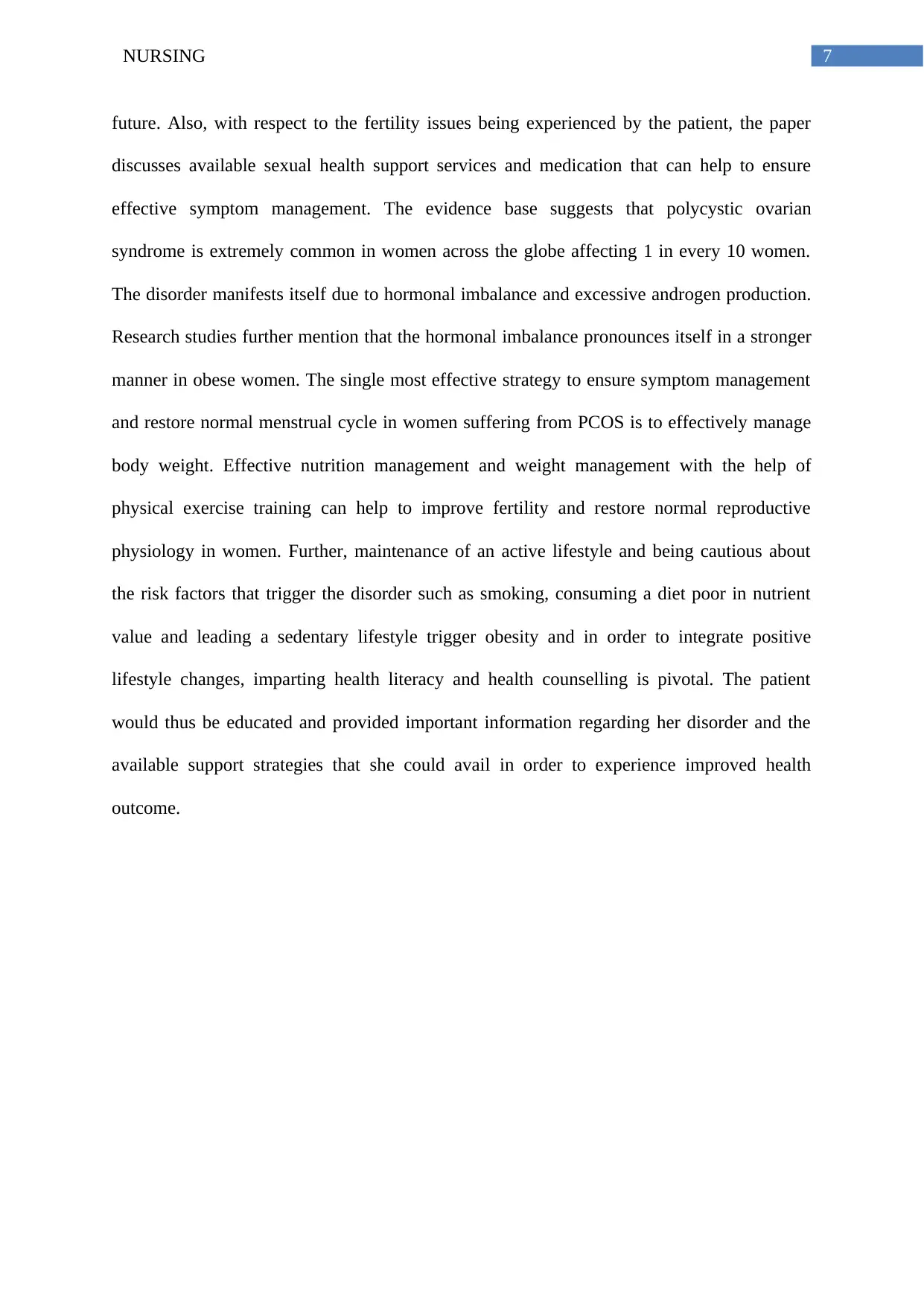
7NURSING
future. Also, with respect to the fertility issues being experienced by the patient, the paper
discusses available sexual health support services and medication that can help to ensure
effective symptom management. The evidence base suggests that polycystic ovarian
syndrome is extremely common in women across the globe affecting 1 in every 10 women.
The disorder manifests itself due to hormonal imbalance and excessive androgen production.
Research studies further mention that the hormonal imbalance pronounces itself in a stronger
manner in obese women. The single most effective strategy to ensure symptom management
and restore normal menstrual cycle in women suffering from PCOS is to effectively manage
body weight. Effective nutrition management and weight management with the help of
physical exercise training can help to improve fertility and restore normal reproductive
physiology in women. Further, maintenance of an active lifestyle and being cautious about
the risk factors that trigger the disorder such as smoking, consuming a diet poor in nutrient
value and leading a sedentary lifestyle trigger obesity and in order to integrate positive
lifestyle changes, imparting health literacy and health counselling is pivotal. The patient
would thus be educated and provided important information regarding her disorder and the
available support strategies that she could avail in order to experience improved health
outcome.
future. Also, with respect to the fertility issues being experienced by the patient, the paper
discusses available sexual health support services and medication that can help to ensure
effective symptom management. The evidence base suggests that polycystic ovarian
syndrome is extremely common in women across the globe affecting 1 in every 10 women.
The disorder manifests itself due to hormonal imbalance and excessive androgen production.
Research studies further mention that the hormonal imbalance pronounces itself in a stronger
manner in obese women. The single most effective strategy to ensure symptom management
and restore normal menstrual cycle in women suffering from PCOS is to effectively manage
body weight. Effective nutrition management and weight management with the help of
physical exercise training can help to improve fertility and restore normal reproductive
physiology in women. Further, maintenance of an active lifestyle and being cautious about
the risk factors that trigger the disorder such as smoking, consuming a diet poor in nutrient
value and leading a sedentary lifestyle trigger obesity and in order to integrate positive
lifestyle changes, imparting health literacy and health counselling is pivotal. The patient
would thus be educated and provided important information regarding her disorder and the
available support strategies that she could avail in order to experience improved health
outcome.
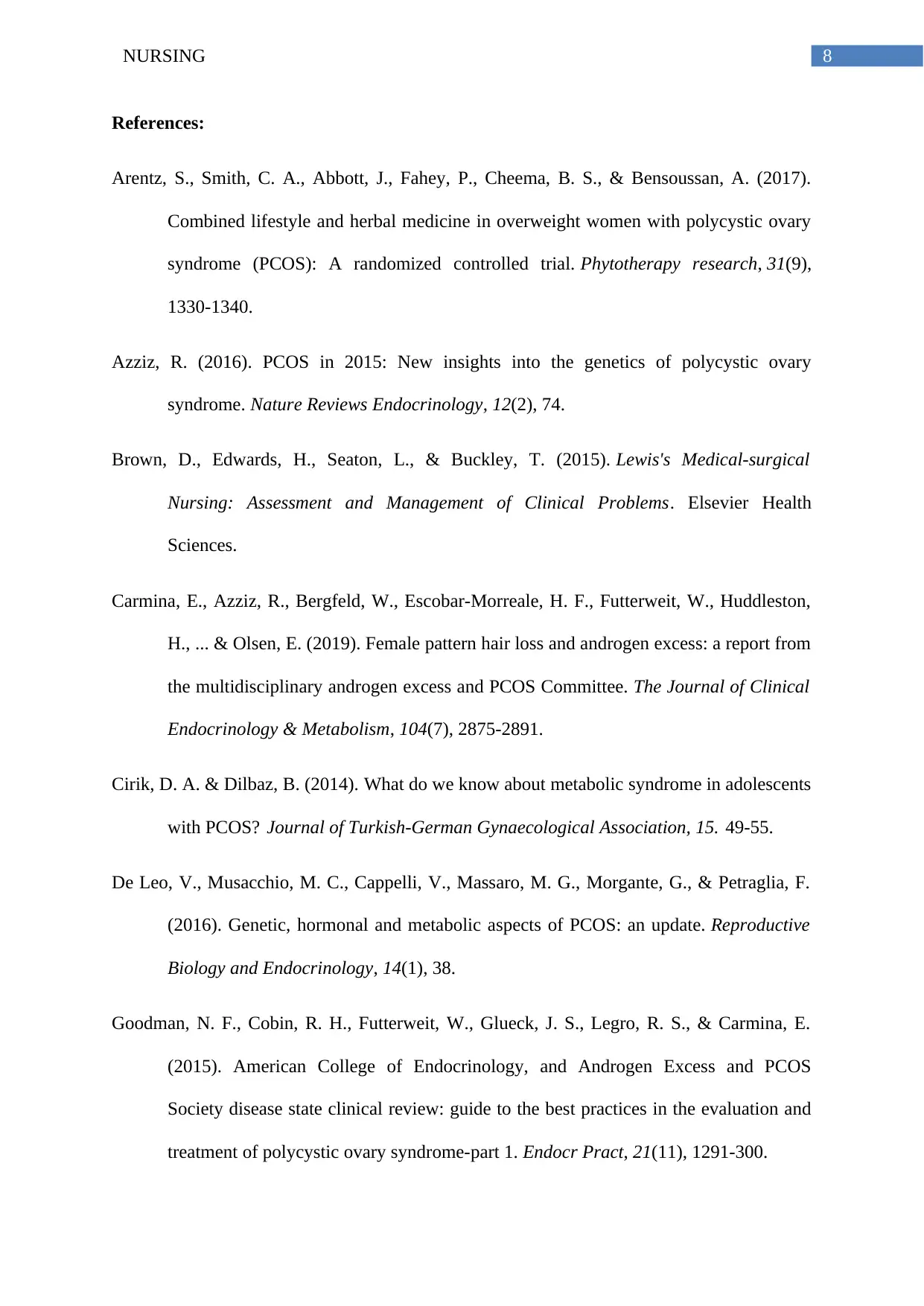
8NURSING
References:
Arentz, S., Smith, C. A., Abbott, J., Fahey, P., Cheema, B. S., & Bensoussan, A. (2017).
Combined lifestyle and herbal medicine in overweight women with polycystic ovary
syndrome (PCOS): A randomized controlled trial. Phytotherapy research, 31(9),
1330-1340.
Azziz, R. (2016). PCOS in 2015: New insights into the genetics of polycystic ovary
syndrome. Nature Reviews Endocrinology, 12(2), 74.
Brown, D., Edwards, H., Seaton, L., & Buckley, T. (2015). Lewis's Medical-surgical
Nursing: Assessment and Management of Clinical Problems. Elsevier Health
Sciences.
Carmina, E., Azziz, R., Bergfeld, W., Escobar-Morreale, H. F., Futterweit, W., Huddleston,
H., ... & Olsen, E. (2019). Female pattern hair loss and androgen excess: a report from
the multidisciplinary androgen excess and PCOS Committee. The Journal of Clinical
Endocrinology & Metabolism, 104(7), 2875-2891.
Cirik, D. A. & Dilbaz, B. (2014). What do we know about metabolic syndrome in adolescents
with PCOS? Journal of Turkish-German Gynaecological Association, 15. 49-55.
De Leo, V., Musacchio, M. C., Cappelli, V., Massaro, M. G., Morgante, G., & Petraglia, F.
(2016). Genetic, hormonal and metabolic aspects of PCOS: an update. Reproductive
Biology and Endocrinology, 14(1), 38.
Goodman, N. F., Cobin, R. H., Futterweit, W., Glueck, J. S., Legro, R. S., & Carmina, E.
(2015). American College of Endocrinology, and Androgen Excess and PCOS
Society disease state clinical review: guide to the best practices in the evaluation and
treatment of polycystic ovary syndrome-part 1. Endocr Pract, 21(11), 1291-300.
References:
Arentz, S., Smith, C. A., Abbott, J., Fahey, P., Cheema, B. S., & Bensoussan, A. (2017).
Combined lifestyle and herbal medicine in overweight women with polycystic ovary
syndrome (PCOS): A randomized controlled trial. Phytotherapy research, 31(9),
1330-1340.
Azziz, R. (2016). PCOS in 2015: New insights into the genetics of polycystic ovary
syndrome. Nature Reviews Endocrinology, 12(2), 74.
Brown, D., Edwards, H., Seaton, L., & Buckley, T. (2015). Lewis's Medical-surgical
Nursing: Assessment and Management of Clinical Problems. Elsevier Health
Sciences.
Carmina, E., Azziz, R., Bergfeld, W., Escobar-Morreale, H. F., Futterweit, W., Huddleston,
H., ... & Olsen, E. (2019). Female pattern hair loss and androgen excess: a report from
the multidisciplinary androgen excess and PCOS Committee. The Journal of Clinical
Endocrinology & Metabolism, 104(7), 2875-2891.
Cirik, D. A. & Dilbaz, B. (2014). What do we know about metabolic syndrome in adolescents
with PCOS? Journal of Turkish-German Gynaecological Association, 15. 49-55.
De Leo, V., Musacchio, M. C., Cappelli, V., Massaro, M. G., Morgante, G., & Petraglia, F.
(2016). Genetic, hormonal and metabolic aspects of PCOS: an update. Reproductive
Biology and Endocrinology, 14(1), 38.
Goodman, N. F., Cobin, R. H., Futterweit, W., Glueck, J. S., Legro, R. S., & Carmina, E.
(2015). American College of Endocrinology, and Androgen Excess and PCOS
Society disease state clinical review: guide to the best practices in the evaluation and
treatment of polycystic ovary syndrome-part 1. Endocr Pract, 21(11), 1291-300.
⊘ This is a preview!⊘
Do you want full access?
Subscribe today to unlock all pages.

Trusted by 1+ million students worldwide
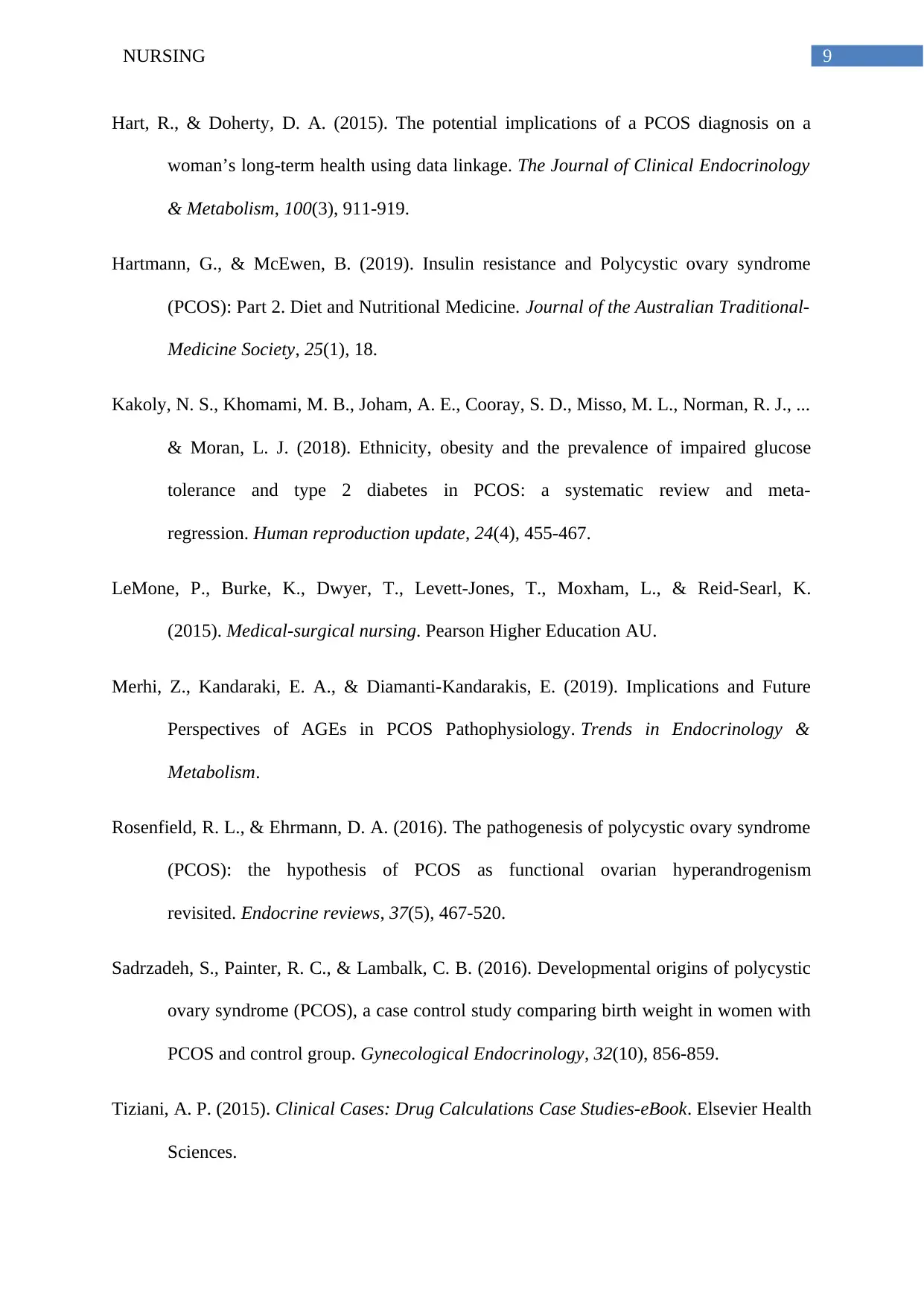
9NURSING
Hart, R., & Doherty, D. A. (2015). The potential implications of a PCOS diagnosis on a
woman’s long-term health using data linkage. The Journal of Clinical Endocrinology
& Metabolism, 100(3), 911-919.
Hartmann, G., & McEwen, B. (2019). Insulin resistance and Polycystic ovary syndrome
(PCOS): Part 2. Diet and Nutritional Medicine. Journal of the Australian Traditional-
Medicine Society, 25(1), 18.
Kakoly, N. S., Khomami, M. B., Joham, A. E., Cooray, S. D., Misso, M. L., Norman, R. J., ...
& Moran, L. J. (2018). Ethnicity, obesity and the prevalence of impaired glucose
tolerance and type 2 diabetes in PCOS: a systematic review and meta-
regression. Human reproduction update, 24(4), 455-467.
LeMone, P., Burke, K., Dwyer, T., Levett-Jones, T., Moxham, L., & Reid-Searl, K.
(2015). Medical-surgical nursing. Pearson Higher Education AU.
Merhi, Z., Kandaraki, E. A., & Diamanti-Kandarakis, E. (2019). Implications and Future
Perspectives of AGEs in PCOS Pathophysiology. Trends in Endocrinology &
Metabolism.
Rosenfield, R. L., & Ehrmann, D. A. (2016). The pathogenesis of polycystic ovary syndrome
(PCOS): the hypothesis of PCOS as functional ovarian hyperandrogenism
revisited. Endocrine reviews, 37(5), 467-520.
Sadrzadeh, S., Painter, R. C., & Lambalk, C. B. (2016). Developmental origins of polycystic
ovary syndrome (PCOS), a case control study comparing birth weight in women with
PCOS and control group. Gynecological Endocrinology, 32(10), 856-859.
Tiziani, A. P. (2015). Clinical Cases: Drug Calculations Case Studies-eBook. Elsevier Health
Sciences.
Hart, R., & Doherty, D. A. (2015). The potential implications of a PCOS diagnosis on a
woman’s long-term health using data linkage. The Journal of Clinical Endocrinology
& Metabolism, 100(3), 911-919.
Hartmann, G., & McEwen, B. (2019). Insulin resistance and Polycystic ovary syndrome
(PCOS): Part 2. Diet and Nutritional Medicine. Journal of the Australian Traditional-
Medicine Society, 25(1), 18.
Kakoly, N. S., Khomami, M. B., Joham, A. E., Cooray, S. D., Misso, M. L., Norman, R. J., ...
& Moran, L. J. (2018). Ethnicity, obesity and the prevalence of impaired glucose
tolerance and type 2 diabetes in PCOS: a systematic review and meta-
regression. Human reproduction update, 24(4), 455-467.
LeMone, P., Burke, K., Dwyer, T., Levett-Jones, T., Moxham, L., & Reid-Searl, K.
(2015). Medical-surgical nursing. Pearson Higher Education AU.
Merhi, Z., Kandaraki, E. A., & Diamanti-Kandarakis, E. (2019). Implications and Future
Perspectives of AGEs in PCOS Pathophysiology. Trends in Endocrinology &
Metabolism.
Rosenfield, R. L., & Ehrmann, D. A. (2016). The pathogenesis of polycystic ovary syndrome
(PCOS): the hypothesis of PCOS as functional ovarian hyperandrogenism
revisited. Endocrine reviews, 37(5), 467-520.
Sadrzadeh, S., Painter, R. C., & Lambalk, C. B. (2016). Developmental origins of polycystic
ovary syndrome (PCOS), a case control study comparing birth weight in women with
PCOS and control group. Gynecological Endocrinology, 32(10), 856-859.
Tiziani, A. P. (2015). Clinical Cases: Drug Calculations Case Studies-eBook. Elsevier Health
Sciences.
Paraphrase This Document
Need a fresh take? Get an instant paraphrase of this document with our AI Paraphraser
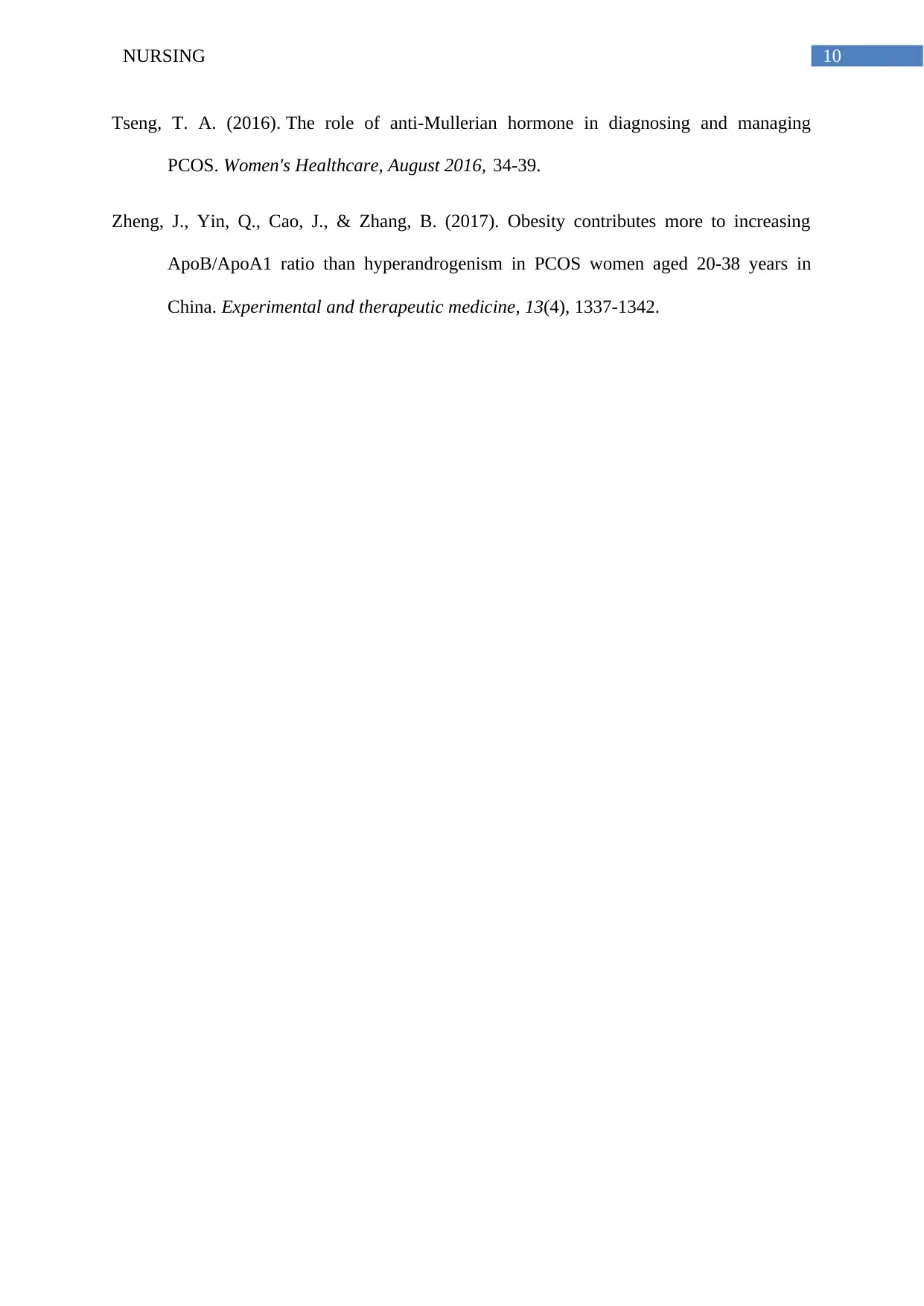
10NURSING
Tseng, T. A. (2016). The role of anti-Mullerian hormone in diagnosing and managing
PCOS. Women's Healthcare, August 2016, 34-39.
Zheng, J., Yin, Q., Cao, J., & Zhang, B. (2017). Obesity contributes more to increasing
ApoB/ApoA1 ratio than hyperandrogenism in PCOS women aged 20-38 years in
China. Experimental and therapeutic medicine, 13(4), 1337-1342.
Tseng, T. A. (2016). The role of anti-Mullerian hormone in diagnosing and managing
PCOS. Women's Healthcare, August 2016, 34-39.
Zheng, J., Yin, Q., Cao, J., & Zhang, B. (2017). Obesity contributes more to increasing
ApoB/ApoA1 ratio than hyperandrogenism in PCOS women aged 20-38 years in
China. Experimental and therapeutic medicine, 13(4), 1337-1342.
1 out of 11
Related Documents
Your All-in-One AI-Powered Toolkit for Academic Success.
+13062052269
info@desklib.com
Available 24*7 on WhatsApp / Email
![[object Object]](/_next/static/media/star-bottom.7253800d.svg)
Unlock your academic potential
Copyright © 2020–2025 A2Z Services. All Rights Reserved. Developed and managed by ZUCOL.





